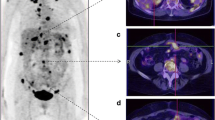Abstract
Purpose
Patients treated for ovarian cancer are usually referred for 2-deoxy-2-[18F]fluoro-D-glucose positron emission tomography/computed tomography (FDG PET/CT) in case of increased Carcinoma Antigen 125 (CA125) but negative conventional imaging. However, there is not enough in the literature to support the value of FDG PET/CT in this context. This study aimed to assess role of FDG PET/CT in a cohort of patients with treated ovarian cancer and correlate the results with serum levels of CA125.
Procedures
We retrospectively studied 175 patients, mean age 65.2 years (range 24–88 years) who had radical treatment for ovarian cancer (chemotherapy, surgery or combination). The patients had a standard FDG PET/CT and measurement of serum CA125 within a month of the scan. PET/CT was considered positive if demonstrated areas of abnormally increased metabolic activity unrelated to physiological distribution, on the basis of a visual analysis. The results of PET/CT imaging were compared to the level of CA125, and receiver operating characteristic (ROC) curves were plotted and area-under-the curve (AUC) statistics were computed. Cytologic or histologic data or clinical and imaging follow-up were taken as gold standard.
Results
Patients were divided into five groups based on CA125 values. The average level of CA125 was 107.7 (range 3–867, SD 166.1). PET/CT was positive in 125/175 cases (71.4%), mean value of CA125 132.2 (SD 182.9) and negative in 50/175 (28.6%), mean value of CA125 46.4 (SD 89.3). In descriptive ROC analyses, the discriminatory power of this marker was relatively high (AUC statistics 0.77, range = 0.703–0.8). The optimal cut-off point of CA125 after treatment to reflect active disease on PET/CT was 18 U/mL achieving a detection rate of 85.6%. There was no relation between PET/CT negativity and the histological type of the tumor.
Conclusion
PET/CT was able to detect active disease at relatively low levels of CA125, thereby facilitating the early diagnosis of recurrence or residual disease. Also in patients with low CA125 levels (<30), PET/CT had a relatively high detection rate (53%). According to our preliminary results, the use of FDG PET/CT in this setting is justified even with low serum CA125 levels.



Similar content being viewed by others
References
Poveda A, Salazar R, del Campo JM, Mendiola C, Cassinello J, Ojeda B (2007) Update in the management of ovarian and cervical carcinoma. Clin Transl Oncol 9:443–451
Lukanova A, Kaaks R (2005) Endogenous hormones and ovarian cancer:Epidemiology ad current hypotheses. Cancer Epidemiol Biomark Prev 14:98–107
Holschneider CH, Berek JS (2000) Ovarian cancer: epidemiology, biology, and prognostic factors. Semin Surg Oncol 19:3–10
Cannistra SA (2004) Cancer of the ovary. N Engl J Med 351:2519–2529
DiSaia P, Creasman W (2002) Epithelial ovarian cancer: clinical Gynecologic Oncology, 6th edn. Mosby, St. Louis, pp 289–350
Burghardt E, Girardi F, Lahousen M, Tamussino K, Stettner H (1991) Patterns of pelvic and paraaortic lymph node involvement in ovarian cancer. Gynecol Oncol 40:103–106
NCCN (2010) Clinical Practice Guidelines in Oncolgy: Ovarian Cancer, including fallopian tube cancer and primary peritoneal cancer, v.2.2010. NCCN, Fort Washington
Bast RC, Klug TL (1983) St. John ER, Jenison E, Niloff JM, Lazarus H, et al. A radio immunoassay using a monoclonal antibody to monitor the course of epithelial ovarian cancer. N Engl J Med 309:883–887
Jacobs I, Bast RC (1989) The CA125 tumour-associated antigen: a review of the literature. Hum Reprod 4:1–12
Nossov V, Amneus M, Su F et al (2008) The early detection of ovarian cancer: From traditional methods to proteomics. Can we really do better than serum CA-125? Am J Obstet Gynecol 99:215–223
Markman M (2003) Optimizing primary chemotherapy in ovarian cancer. Hematol Oncol Clin North Am 17:957–968
Behbakht K, Randall TC, Benjamin I, Morgan MA, King S, Rubin SC (1998) Clinical characteristics of clear cell carcinoma of the ovary. Gynecol Oncol 70:255–258
Bast RC Jr, Badgwell D, Lu Z, Marquez R, Rosen D, Liu J et al (2005) New tumour markers: CA125 and beyond. Int J Gynecol Cancer 15:274–281
Kang S, Kim TJ, Nam BH, Seo SS, Kim BG, Bae DS et al (2010) Preoperative Serum CA-125 Levels and Risk of Suboptimal Cytoreduction in Ovarian Cancer: A Meta-Analysis. J Surg Oncol 101:13–17
Kenemans P, van Kamp GJ, Oehr P, Verstraeten RA (1993) Heterologous double-determinant immunoradiometric assay CA 125 II: reliable second-generation immunoassay for determining CA 125 in serum. Clin Chem 39:2509–2513
Rustin GJ, Marples M, Nelstrop AE, Mahmoudi M, Meyer T (2001) Use of CA-125 to define progression of ovarian cancer in patients with persistently elevated levels. J Clin Oncol 19:4054–4057
Han LY, Karavasilis V, van Hagen T, Nicum S, Thomas K, Harrison M (2010) Doubling time of serum CA125 is an independent prognostic factor for survival in patients with ovarian cancer relapsing after first-line chemotherapy. Eur J Cancer. doi:10.1016/j.ejca.2010.02.012
Torizuka T, Nobezawa S, Kanno T et al (2002) Ovarian cancer recurrence: role of whole-body positron emission tomography using 2-[fluorine-18]- fluoro-2-deoxy-d-glucose. Eur J Nucl Med Mol Imaging 29:797–803
Garcia-Velloso MJ, Jurado M, Ceamanos C et al (2007) Diagnostic accuracy of FDG PET in the follow-up of platinum-sensitive epithelial ovarian carcinoma. Eur J Nucl Med Mol Imaging 34:1396–1405
Hogdall EV, Christensen L, Kjaer SK, Blaakaer J, Kjaerbye-Thygesen A, Gayther S et al (2007) CA125 expression pattern, prognosis and correlation with serum CA125 in ovarian tumour patients. From The Danish “MALOVA” Ovarian Cancer Study. Gynecol Oncol 104:508–515
Conflict of Interest Statement
The authors declare no conflict of interest with the present paper.
Author information
Authors and Affiliations
Corresponding authors
Additional information
Azahara Palomar and Cristina Nanni contributed equally to the paper.
Rights and permissions
About this article
Cite this article
Palomar, A., Nanni, C., Castellucci, P. et al. Value of FDG PET/CT in Patients with Treated Ovarian Cancer and Raised CA125 Serum Levels. Mol Imaging Biol 14, 123–129 (2012). https://doi.org/10.1007/s11307-010-0468-9
Published:
Issue Date:
DOI: https://doi.org/10.1007/s11307-010-0468-9




